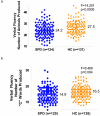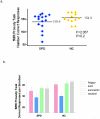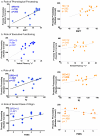Factors in sensory processing of prosody in schizotypal personality disorder: an fMRI experiment
- PMID: 20362418
- PMCID: PMC2905482
- DOI: 10.1016/j.schres.2010.03.008
Factors in sensory processing of prosody in schizotypal personality disorder: an fMRI experiment
Abstract
Introduction: Persons diagnosed with schizophrenia demonstrate deficits in prosody recognition. To examine prosody along the schizophrenia spectrum, antipsychotic-naïve schizotypal personality disorder (SPD) subjects and healthy control subjects were compared. It was hypothesized that SPD subjects would perform more poorly; with cognitive and demographic factors contributing to the poor performance. The superior temporal gyrus (STG) was selected as the region-of-interest (ROI) given its known abnormalities in SPD and its important role in the processing of prosody.
Methods: SPD and healthy comparison (HC) subjects were matched on age, IQ, and parental social-economic status (PSES). Cognitive measures included the Speech Sound Perception Test (SSPT) to examine phonological processing (SPD=68, HC=74) and the Verbal Fluency task to examine executive functioning (SPD=129, HC=138). The main experiment was a novel fMRI task of prosody identification using semantically neutral sentences spoken with emotional prosody (SPD=16, HC=13). Finally, volumetric measurement of the superior temporal sulcus (STS), a key region for processing prosody, and partially overlapping with the STG, was performed (SPD=30, HC=30).
Results: Phonological processing and executive functioning were both impaired in SPD subjects compared with HC subjects. Contrary to the prediction, SPD subjects, as a group, were similar to HC subjects in terms of correctly indentifying the emotion conveyed and reaction time. Within the SPD group, prosody identification accuracy was influenced by executive functioning, IQ and perhaps PSES, relationships not found with HC subjects. Phonological perception aided prosody identification in both diagnostic groups. As expected, both groups activated the STG while performing the prosody identification task. However, SPD subjects may have been less "efficient" in their recruitment of STG neurons. Finally, SPD subjects demonstrated a trend toward smaller STS volumes on the left, particularly the lower bank.
Conclusions: These data suggest that subtle differences between SPD and controls in phonological processing, executive functioning, IQ, and possibly PSES, contributed to difficulty in processing prosody for some SPD subjects.
Published by Elsevier B.V.
Figures










Similar articles
-
Auditory processing abnormalities in schizotypal personality disorder: an fMRI experiment using tones of deviant pitch and duration.Schizophr Res. 2008 Aug;103(1-3):26-39. doi: 10.1016/j.schres.2008.04.041. Epub 2008 Jun 13. Schizophr Res. 2008. PMID: 18555666 Free PMC article.
-
Working memory in schizotypal personality disorder: fMRI activation and deactivation differences.Schizophr Res. 2013 Dec;151(1-3):113-23. doi: 10.1016/j.schres.2013.09.013. Epub 2013 Oct 23. Schizophr Res. 2013. PMID: 24161536
-
Schizotypal personality disorder and MRI abnormalities of temporal lobe gray matter.Biol Psychiatry. 1999 Jun 1;45(11):1393-402. doi: 10.1016/s0006-3223(99)00030-x. Biol Psychiatry. 1999. PMID: 10356620 Free PMC article.
-
A review of structural MRI and diffusion tensor imaging in schizotypal personality disorder.Curr Psychiatry Rep. 2012 Feb;14(1):70-8. doi: 10.1007/s11920-011-0241-z. Curr Psychiatry Rep. 2012. PMID: 22006127 Free PMC article. Review.
-
Emotion processing deficits in the different dimensions of psychometric schizotypy.Scand J Psychol. 2016 Jun;57(3):256-70. doi: 10.1111/sjop.12287. Scand J Psychol. 2016. PMID: 27119257 Review.
Cited by
-
Cognition and brain function in schizotypy: a selective review.Schizophr Bull. 2015 Mar;41 Suppl 2(Suppl 2):S417-26. doi: 10.1093/schbul/sbu190. Schizophr Bull. 2015. PMID: 25810056 Free PMC article. Review.
-
Basic auditory processing and emotion recognition in individuals at clinical high risk for psychosis.Schizophr Res Cogn. 2021 Nov 17;27:100225. doi: 10.1016/j.scog.2021.100225. eCollection 2022 Mar. Schizophr Res Cogn. 2021. PMID: 34840961 Free PMC article. No abstract available.
-
Prosodic abnormalities in schizotypal personality disorder.Schizophr Res. 2012 Dec;142(1-3):20-30. doi: 10.1016/j.schres.2012.09.006. Epub 2012 Oct 12. Schizophr Res. 2012. PMID: 23068317 Free PMC article.
-
Cerebral responses to vocal attractiveness and auditory hallucinations in schizophrenia: a functional MRI study.Front Hum Neurosci. 2013 May 24;7:221. doi: 10.3389/fnhum.2013.00221. eCollection 2013. Front Hum Neurosci. 2013. PMID: 23745111 Free PMC article.
-
Out of touch with reality? Social perception in first-episode schizophrenia.Soc Cogn Affect Neurosci. 2013 Apr;8(4):394-403. doi: 10.1093/scan/nss012. Epub 2012 Jan 24. Soc Cogn Affect Neurosci. 2013. PMID: 22275166 Free PMC article.
References
-
- Diagnostic and statistical manual of mental disorders. American Psychiatric Association; Washington, DC: 1994.
-
- Addington J, Addington D. Facial affect recognition and information processing in schizophrenia and bipolar disorder. Schizophr Res. 1998;32:171–81. - PubMed
-
- Amaro E, Jr., Williams SC, Shergill SS, Fu CH, MacSweeney M, Picchioni MM, Brammer MJ, McGuire PK. Acoustic noise and functional magnetic resonance imaging: current strategies and future prospects. J Magn Reson Imaging. 2002;16:497–510. - PubMed
-
- Avlund K, Damsgaard M, Holstein B. Social relations and mortality. An eleven year follow-up study of 70-year-old men and women in Denmark. Soc Sci Med. 1998;47:635–643. - PubMed
-
- Bach DR, Buxtorf K, Grandjean D, Strik WK. The influence of emotion clarity on emotional prosody identification in paranoid schizophrenia. Psychol Med. 2009a;39:927–38. - PubMed
Publication types
MeSH terms
Substances
Grants and funding
LinkOut - more resources
Full Text Sources
Medical
Research Materials

